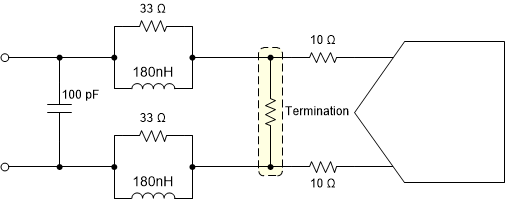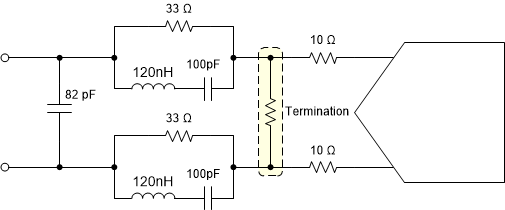JAJSLC0 March 2024 ADC3683-SP
PRODMIX
- 1
- 1 特長
- 2 アプリケーション
- 3 概要
- 4 Pin Configuration and Functions
-
5 Specifications
- 5.1 Absolute Maximum Ratings
- 5.2 ESD Ratings
- 5.3 Recommended Operating Conditions
- 5.4 Thermal Information
- 5.5 Electrical Characteristics - Power Consumption
- 5.6 Electrical Characteristics - DC Specifications
- 5.7 Electrical Characteristics - AC Specifications
- 5.8 Timing Requirements
- 5.9 Typical Characteristics
- 6 Parameter Measurement Information
- 7 Detailed Description
- 8 Application Information Disclaimer
- 9 Register Map
- 10Device and Documentation Support
- 11Revision History
- 12Mechanical, Packaging, and Orderable Information
7.3.1.1.1 Sampling Glitch Filter Design
The front end sampling glitch filter is designed to optimize the SNR and HD3 performance of the ADC. The filter performance is dependent on input frequency: therefore, the following filter designs are recommended for different input frequency ranges as shown in Figure 7-2 and Figure 7-3 (assuming a 50Ω source impedance).
 Figure 7-2 Sampling Glitch Filter Example for Input Frequencies From DC to 30MHz
Figure 7-2 Sampling Glitch Filter Example for Input Frequencies From DC to 30MHz Figure 7-3 Sampling Glitch Filter Example for Input Frequencies From 30 to 70MHz
Figure 7-3 Sampling Glitch Filter Example for Input Frequencies From 30 to 70MHz